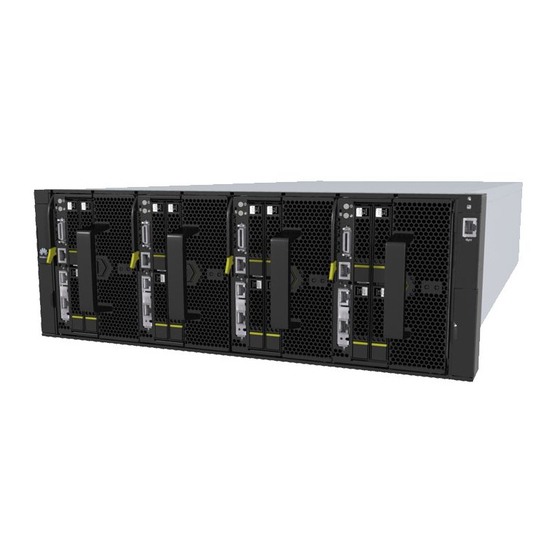
Summarization of Contents
Safety Instructions
General Instructions
General safety guidelines for hardware installation and operation.
Personal Safety
Guidelines for personnel safety during equipment handling and installation.
Weight Limits Per Person
Specifies maximum handling weight limits per person based on standards.
Preparing for Troubleshooting
Basic Knowledge and Skills
Essential knowledge and skills required before starting server troubleshooting.
Essential Materials
Lists necessary materials to read before performing routine maintenance.
Software Tools
Details software tools required for routine maintenance and troubleshooting.
Hardware Tools
Lists essential hardware tools required for routine maintenance.
Collecting Information
4.1 Collecting Basic Information
Details essential information to collect before submitting a service request for server faults.
4.2 Collecting OS Logs
Provides methods for collecting OS logs after an OS fault occurs.
4.3 Collecting Hardware Logs
Describes how to collect hardware logs after a hardware fault occurs.
4.4 Collecting Switch Module Logs (for E9000+MM910)
Explains how to collect logs from switch modules for E9000 servers with MM910.
4.5 Collecting Switch Module Logs (for E9000+MM910/MM921)
Details collecting switch module logs for E9000 servers with MM910/MM921.
4.6 Collecting Qlogic HBA Logs
Describes how to collect QLogic HBA logs when an NIC is faulty.
4.7 Collecting Other Logs
Explains methods for collecting other host logs, including Emulex HBA logs.
Diagnosing and Rectifying Faults
5.1 Fault Diagnosis Rules
Provides general rules and guidelines for diagnosing and rectifying server faults.
5.2 Using Tools to Diagnose Faults
Details diagnostic tools like FusionServer Tools Toolkit and Smart Provisioning.
5.3 Handling Alarms
Explains how to use the server management system to handle alarms.
5.4 Using Error Codes to Locate Faults
Discusses using error codes and fault diagnosis LEDs to locate faults.
5.5 Checking Indicators to Locate Faults
Guides on interpreting server status indicators for fault diagnosis.
5.6 Handling Faults Based on Symptoms
Provides methods to diagnose and rectify faults based on observed symptoms.
Preventive Maintenance
7.1 Inspecting the Equipment Room Environment and Cable Layout
Covers inspection of equipment room environment and cable layout for preventive maintenance.
7.2 Inspecting Servers
Details procedures for inspecting servers, including indicators and system status.
7.3 Huawei Server Inspection Report
Provides a template for Huawei Server Inspection Reports.
Common Operations
8.1 Obtaining a Product SN
Explains how to obtain the Serial Number (SN) or Equipment Serial Number (ESN) of a Huawei server.
8.2 Using iMana 200 to Collect Information in Batches
Describes collecting logs from switch modules in batches using iMana 200.
8.3 Using iBMC to Collect Information in Batches
Details how to collect server information in batches using the iBMC WebUI.
8.4 Using the MM910 WebUI to Collect Information in Batches (for Versions Earlier Than U54 2.20)
Explains collecting logs from MM910 in batches for older versions.
8.5 Using the MM910 WebUI to Collect Information in Batches (for U54 2.20 or Later)
Explains collecting logs from MM910 in batches for newer versions.
8.6 Using the FusionDirector WebUI to Collection Information in Batches
Describes collecting logs in batches using the FusionDirector WebUI for MM920/MM921.
8.7 Using the MM510 CLI to Collect Information (FusionServer Pro G5500)
Explains collecting information using the MM510 CLI for FusionServer Pro G5500.
8.8 Logging In to the iMana 200 WebUI
Provides instructions on how to log in to the iMana 200 WebUI using a browser.
8.9 Logging In to the iBMC WebUI
Details how to log in to the iBMC WebUI using a browser on a local PC.
8.10 Logging In to the Web Tools of the MX510
Guides on logging into the Web Tools of the MX510 for configuration and management.
8.11 Logging In to the MM910 WebUI
Explains how to log in to the MM910 WebUI for chassis and component management.
8.12 Logging In to the FusionDirector WebUI
Describes how to log in to the FusionDirector WebUI to manage chassis and cluster devices.
8.13 Logging In to the MM510 CLI
Explains how to log in to the MM510 CLI for management module access.
8.14 Logging In to the RMC CLI
Details how to log in to the Rack Management Controller (RMC) CLI.
8.15 Logging In to a Server Over a Network Port by Using PuTTY
Guides on using PuTTY to remotely log in to a server via a network port.
8.16 Logging In to a Server Over a Serial Port by Using PuTTY
Explains how to use PuTTY to log in to a server via a serial port.
8.17 Logging In to a Compute Node, Passthrough Module, or Switch Module by Using the SOL Function of the MM910
Describes using SOL function of MM910 to access compute/passthrough/switch modules.
8.18 Logging In to a Compute Node, Passthrough Module, or Switch Module by Using the SOL Function of the MM920/MM921
Describes using SOL function of MM920/MM921 to access compute/passthrough/switch modules.
8.19 Using WinSCP to Transfer Files
Guides on using WinSCP to transfer files between a PC and a server.
8.20 Configuring an FTP Server
Explains how to configure an FTP server for file transfer.
8.21 Using SFTP to Transfer Files
Describes how to transfer files using SFTP on a local PC.
Other Resources
9.1 Obtaining Technical Support
Provides information on obtaining technical support through various channels.
9.2 Product Information Resources
Lists resources for obtaining product information like user guides.
9.3 Product Configuration Resources
Details product configuration resources such as videos and assistants.
9.4 Maintenance Tools
Lists software tools required for routine maintenance of Huawei servers.















Need help?
Do you have a question about the 9010 and is the answer not in the manual?
Questions and answers